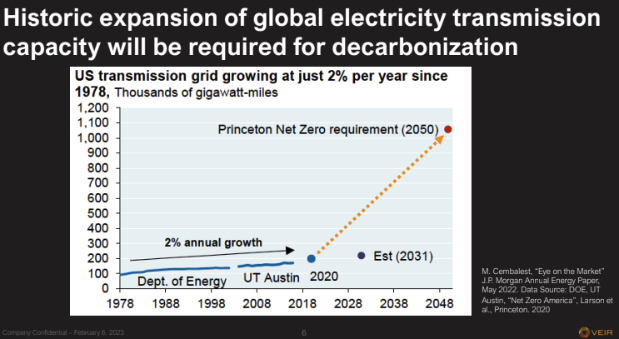The world must triple our renewable energy capacity by 2030 if we want to stay on a pathway of 1.5C, a transformation at a scale not seen since the Industrial Revolution.1 And we are making good progress – in 2022 renewables made up 83% of all added power capacity, and the IEA estimates this speed will continue through 2023, with renewable power capacity expected to increase by a whopping 30% by 2027.2
But while this recent increase in renewable energy generation has been remarkable, our rate of deployment is not close to where it needs to be, increasingly due to the need for greater transmission capacity. By some estimates 1,300 GW of wind, solar, and storage projects are currently stuck in interconnection queues across the US, representing close to 90% of total existing renewable capacity.3 Only 23% of the projects seeking a connection from 2000 to 2016 have subsequently been built – and there are indications that completion has been declining.4 We believe there is a real risk that many of the 2022 Inflation Reduction Act’s renewable incentives will not be utilized due to an inability to expand this infrastructure.
But modernizing our grid and increasing transmission capacity has hurdles of its own. New transmission developers have to navigate limited available land and pushback from stakeholders who are resistant to the physical and visual footprint of new transmission lines and infrastructure. Additionally, the best renewable resources lie far from demand centers, resulting in electricity losses of up to 30% on continental lines with existing technology.5
In addition to the challenges of the interconnection process, increased electrification and the ubiquity of power-hungry technologies like AI and advanced computing could drive significant load growth.

We believe that VEIR, with its innovative and cost-effective high temperature superconductor (HTS) transmission technology, is positioned to address these current and future issues.
VEIR’s technology can bring the efficiency benefits of HTS, which have limited electricity losses due to the use of near-zero resistance HTS tape, without the prohibitive costs of existing HTS technology. This is because VEIR’s evaporative cryogenic cooling technology allows for a simpler, lighter fit that can be used overhead, avoiding the need for expensive underground line buildouts.
The ability to build above-ground also helps VEIR address transmission’s footprint issue. Unlike other HTS solutions, it can be used to replace existing overhead power lines. And because we believe VEIR’s cable could deliver five times more power than conventional approaches, this also means a smaller physical footprint is required to transmit an equivalent amount of power.
Under Tim Heidel, VEIR is making impressive strides towards bringing this potentially significant technology to market, including a first-of-its-kind demonstration of an outdoor overhead superconducting power line. This follows the announcement last fall of a five-year agreement between VEIR and National Grid to develop VEIR’s solution at a utility scale, with testing expected at National Grid’s facilities in Millbury, Mass. and the UK.
That’s why the Galvanize team is so excited to announce our participation in VEIR’s series A alongside Breakthrough Energy Ventures, The Engine, Congruent Ventures, and Fine Structure Ventures. If we are going to meet the challenge of the climate crisis, we have to solve the challenge of transmission – we believe VEIR has the potential to be a critical part of that puzzle.
1. Record growth in renewables achieved despite energy crisis (IRENA)
2. Renewable power on course to shatter more records as countries around the world speed up deployment (IEA)
3.Record amounts of zero-carbon electricity generation and storage now seeking grid interconnection (Berkeley Lab)
4. Record amounts of zero-carbon electricity generation and storage now seeking grid interconnection (Berkeley Lab)
5. VEIR (VEIR)